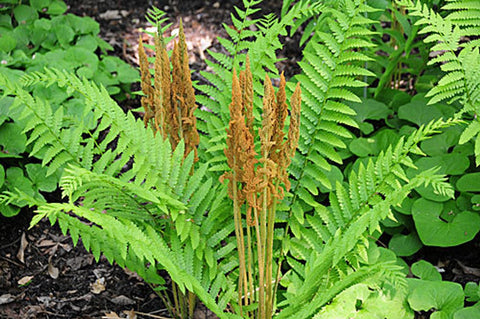

Cinnamon ferns - Osmundastrum
Cinnamon ferns thrive in swampy environments and moisture-rich mountain slopes of North America's eastern side. Cinnamon ferns are head-turning beauties, and these stately plants can grow to over 4 feet tall (1 meter). Moreover, you will come across two distinct types of cinnamon ferns. So, it is unsurprising their fronds have distinctive textures and colors that can enhance the attractiveness of a shady landscape. Continue reading to learn more about cinnamon ferns and how you can grow them in your garden or indoor space.
Cinnamon Ferns For Sale
There are two distinct types of cinnamon fern fronds. You will come across fertile cinnamon-colored fronds growing at the center of the plant. These fronds are plume-like and surrounded by large, green, and sterile fronds. Consequently, the beautiful contrast between the distinct fronds results in an attractive, appealing, and multi-dimensional plant.
Cinnamon ferns that boast short rhizomes can be subdivided into two or more healthy plants. Use a sharp, pruning scissor or blade to mitigate tissue damage while separating the fibrous rhizomes. Also, remember to replant the divisions immediately to ensure the survival of the new plants.
You are cinnamon ferns will thrive and develop healthy foliage if you give them a lot of water. Naturally, these plants grow in coastal areas, swampy regions, stream beds, and moisture-rich environments like the swamplands that stretch from Texas to Florida. Yes, cinnamon ferns can adapt to garden conditions, primarily if you can provide them with a moisture-rich environment.
When is the best time to Plant Cinnamon Fern?
Spring is the best season to plant cinnamon ferns. Individuals who want their cinnamon ferns to develop healthy, vibrant, and attractive foliage should grow their plants at the onset of spring, after the last frost season. Cinnamon fern spacing is dependent on garden size and personal preferences. However, it will be best to space your cinnamon ferns at least 6 feet apart for tropical appeal. Alternatively, you can space these plants 2 feet apart to create a lively backdrop for summer and spring wildflowers. Lastly, plant your cinnamon ferns at the base of designated trees to enhance your garden's look.
HOW TO GROW A CINNAMON FERN
Spice up the appearance of your outdoor space or garden by growing cinnamon ferns. Avoid planting your cinnamon fern plants in direct sunlight. These plants thrive in an environment that has filtered sunlight. Individuals living in hot areas all year round will be pleased to learn that cinnamon fans can survive direct sunlight exposure if growing in wet soil.
It will be best to keep your cinnamon ferns growing in wet soil at all times, especially if you want to avoid constant watering or have a busy schedule. You don't have to shop for a specific potting mix or soil for your cinnamon ferns. These plants can grow and adapt to different soil types. Nevertheless, growing your cinnamon ferns in well-draining, moisture-rich, and organic soil will guarantee their fast and healthy growth.
BUY CINNAMON FERN ONLINE AT NANCE PLANTS.
FAQ
1. Are Cinnamon Ferns Worth It?
A. Yes, cinnamon ferns are worth it. Unlike native plants, you won't sweat when searching for cinnamon ferns in nurseries because this beautiful plant is common with shade gardeners across the US. You will also discover that numerous garden centers and nurseries in the US stock cinnamon ferns or have access to ordering it. So, homeowners in the market for Ideal landscaping plants should consider the cinnamon fern if they want a perfect and friendly plant for outdoor or indoor spaces.
2. Do Cinnamon ferns multiply?
A. Yes, cinnamon ferns (Osmundastrum cinnamomeum), like many ferns, can multiply and spread through a process known as vegetative reproduction.
One Year Guarantee on all Perennials & Ferns. See Healthy Plant Guarantee for more details.
Color:
Green
Ships As:
Root/Rhizome
Season:
Summer, Fall
Height:
3-6 Feet
Zone:
3-8
Exposure:
Full to Partial Shade
Deer Resistant:
Yes
Native:
Yes




